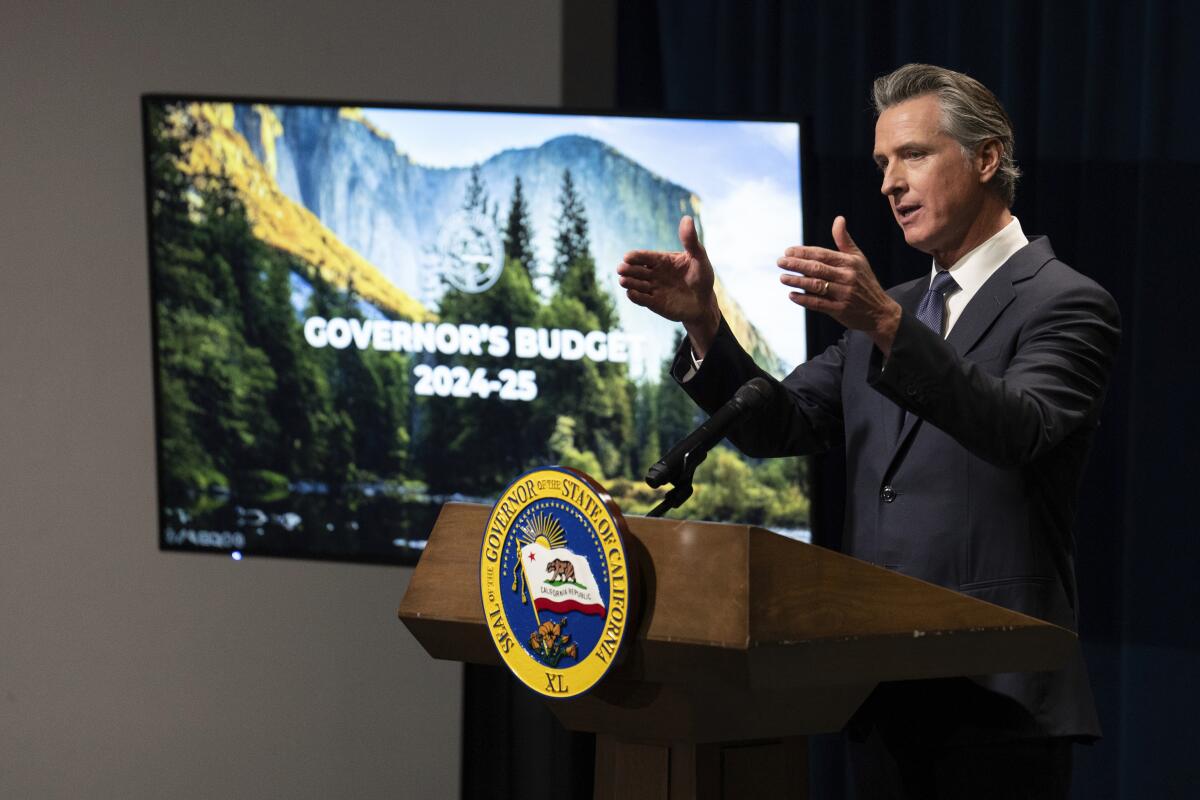Column: Newsom’s budget plan reflects his rosy view of the economy

- Share via
SACRAMENTO — How do you cut a colossal $68-billion state budget deficit nearly in half? Easy. With a pencil.
You simply erase the “68” and write in “38.”
I’m being only half facetious.
Budgeting in Sacramento is basically guesswork anyway. One number — one tax revenue calculation — is essentially as valid as another at this stage. It’s five months before a budget must be passed by the Legislature.
Gov. Gavin Newsom chose to take a relatively rosy view of the 2024 economy Wednesday in sending the Legislature a roughly $292-billion spending plan for the next fiscal year, which starts July 1.
Still, Newsom’s proposal is around $20 billion smaller than the current budget. Here’s guessing that gap will practically disappear after the governor and legislative leaders finish negotiating the final product. Liberal Democrats control California’s Capitol, after all.
Newsom’s cheery economic outlook contrasts with how the nonpartisan Legislative Analyst’s Office saw things last month. The office — the Legislature’s own highly respected number cruncher — issued a much more pessimistic forecast. It implied risk of a recession and calculated the budget deficit at $68 billion.
“We’re just a little more optimistic,” the governor said in unveiling his budget proposal to reporters. “We don‘t see a recession.”
As he customarily does, Newsom displayed a remarkable memory bank for numbers, articulately reciting data nonstop for nearly two hours.
California taxpayers and primary users of state services will benefit from Newsom’s confidence in a rebounding economy — at least for now. It means there won’t be a serious push to raise taxes. Nor will there be deep cuts in education and healthcare.
The spending cuts could become more severe later if Newsom’s revenue projections are off base.
But hardly any politician wants to raise taxes in an election year — or in any year for a governor who dreams of one day sitting in the Oval Office and seems to be limbering up for a 2028 presidential race.
The governor couldn’t have been more clear about the fact he has no interest in a broad-based tax increase.
“Why the hell do you keep writing about that?” he asked reporters, referring to speculation about tax hikes and particularly targeting Wall Street Journal editorial pages. “The state pays a price for the misrepresentation and lies.”
Asked later by a reporter whether he was committed to no major tax increase, the frustrated governor replied: “I’m just not going to say it again. I say it every year.”
So, how does Newsom propose to balance the books?
For starters, the governor whacks $30 billion off the Legislative Analyst’s Office’s deficit forecast. He assumes the economy will generate more tax revenue — $15 billion more — than does Legislative Analyst Gabriel Petek. And he figures that the amount of required state school aid is $10 billion less than what the office calculates.
After that, Newsom taps into $13 billion in reserves.
He makes $8.5 billion in spending cuts, most notably in climate and housing programs.
There’s a narrowly focused tax paid by managed-care organizations that service Medi-Cal recipients. It would generate close to $4 billion.
He wants to delay spending on $5 billion worth of items, such as transit and intercity rail, higher provider rates for serving developmentally disabled people, preschool programs and clean energy investment.
General fund spending worth $3.4 billion would be shifted to other kitties, such as the cap-and-trade program that pays for climate programs.
There’s also $2 billion in accounting gimmicks. One example: Pay state employees on July 1 rather than June 30 so the spending can be counted in the next fiscal year.
How did the state stumble into this red ink hole, falling from a $100-billion budget surplus just 18 months ago?
One short-term reason is that the federal government extended the normal tax filing deadline last year from April until November to ease life for Californians harmed by record winter storms. That meant Newsom and legislators didn’t know how much tax revenue to expect before passing the current budget in June. So, they took the easy way out and overestimated tax collections.
“We had a blindfold on,” Newsom said. If they’d been able to see clearly, he asserted, spending would have been adjusted downward.
Maybe. But their natural tendency was to spend more, not less.
The bigger long-range problem is that Sacramento continually rides a roller-coaster tax system that reacts erratically to good and bad times. It’s either boom or bust for the state treasury. But the politicians don’t have the will or courage to fix it.
The top 1% of earners pay nearly 50% of the state income tax, which supplies two-thirds of Sacramento’s revenue. Their capital gains feed the vault in a robust economy but are reduced to a trickle when investment earnings are weak.
One long-sought reform that has never gained traction is to broaden the tax base: Reduce California’s highest-in-the-nation 13.3% income tax rate and extend the sales tax to services, such as legal and accounting.
Asked about that Wednesday, Newsom replied, “It’s the art of the possible.” And reform seems politically impossible.
Anyway, Newsom said, he prefers to keep California’s very progressive income tax system and simply save more money in good times to use in bad times. He wants to tweak the law to allow for higher savings.
This is Newsom’s opening salvo in budget negotiations with legislative leaders.
It’s a good bet that even the governor’s minimal cuts will be eased and spending increased. Liberal Democrats own the place.
More to Read
Sign up for Essential California
The most important California stories and recommendations in your inbox every morning.
You may occasionally receive promotional content from the Los Angeles Times.











